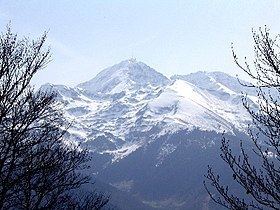Prominence 761 m | Elevation 2,877 m | |
 | ||
Similar Néouvielle massif, Vignemale, Pic du Midi d'Ossau, Aneto, Pic de Bugatet | ||
Pic du midi de bigorre
The Pic du Midi de Bigorre or simply the Pic du Midi (altitude 2,877 m (9,439 ft)) is a mountain in the French Pyrenees famous for its Pic du Midi Observatory.
Contents
- Pic du midi de bigorre
- Map of Pic du Midi de Bigorre 65120 BagnC3A8res de Bigorre France
- Descente du pic du midi de bigorre 25 janvier 2017
- Pic du Midi Observatory
- List of discovered minor planets
- References
Map of Pic du Midi de Bigorre, 65120 Bagn%C3%A8res-de-Bigorre, France
Descente du pic du midi de bigorre 25 janvier 2017
Pic du Midi Observatory
The Pic du Midi Observatory (French: Observatoire du Pic du Midi) is an astronomical observatory located at 2877 meters on top of the Pic du Midi de Bigorre mountain in the French Pyrenees. It is part of the Midi-Pyrenees Observatory (French: Observatoire Midi-Pyrénées; OMP) which has additional research stations in the southwestern French towns of Tarbes, Lannemezan, and Auch, as well as many partnerships in South America, Africa, and Asia, due to the guardianship it receives from the French Research Institute for Development (IRD).
Construction of the observatory began in 1878 under the auspices of the Société Ramond, but by 1882 the society decided that the spiralling costs were beyond its relatively modest means, and yielded the observatory to the French state, which took it into its possession by a law of 7 August 1882. The 8 metre dome was completed in 1908, under the ambitious direction of Benjamin Baillaud. It housed a powerful mechanical equatorial reflector which was used in 1909 to formally discredit the Martian canal theory. In 1946 Mr. Gentilli funded a dome and a 0.60-meter telescope, and in 1958, a spectrograph was installed.
A 1.06-meter (42-inch) telescope was installed in 1963, funded by NASA and was used to take detailed photographs of the surface of the Moon in preparation for the Apollo missions. In 1965 the astronomers Pierre and Janine Connes were able to formulate a detailed analysis of the composition of the atmospheres on Mars and Venus, based on the infrared spectra gathered from these planets. The results showed atmospheres in chemical equilibrium. This served as a basis for James Lovelock, a scientist working for the Jet Propulsion Laboratory in California, to predict that those planets had no life - a fact that would be proven and scientifically accepted years after.
A 2-meter telescope, known as the Bernard Lyot Telescope was placed at the observatory in 1980 on top of a 28-meter column built off to the side to avoid wind turbulence affecting the seeing of the other telescopes. It is the largest telescope in France. The observatory also has a coronagraph, which is used to study the solar corona. A 0.60-meter telescope (the Gentilly's T60 telescope) is also located at the top of Pic du Midi. Since 1982 this T60 is dedicated to amateur astronomy and managed by a group of amateurs, called association T60.
There are currently at the top:
Also:
The observatory is located at 42°56′N 0°8′E, placing it very close to the Greenwich meridian. The observatory was featured in the video game Rainbow Six: Vegas 2 under a different name. The observatory in-game is said to be located on the fictional Pic des Pyrenees.
Saturn's moon Helene (Saturn XII or Dione B), was discovered by French astronomers Pierre Laques and Jean Lecacheux (MPC) in 1980 from ground-based observations at this observatory, and named Helene in 1988. It is also a trojan moon of Dione.
The main-belt asteroid 20488 Pic-du-Midi, discovered at Pises Observatory in 1999, was named for the observatory and the mountain its located on.
List of discovered minor planets
The Minor Planet Center credits the discovery of the following minor planets directly to the observatory (as of 2017, no discoveries have been assigned to individual astronomers):
